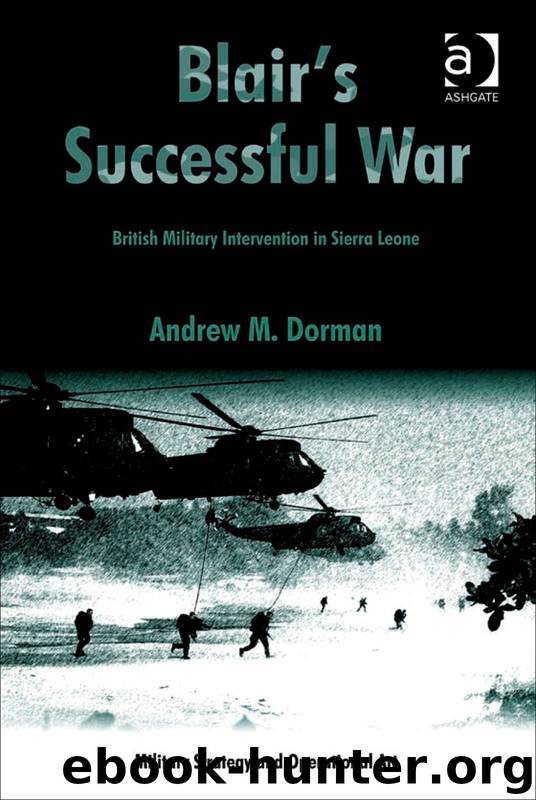Blair's Successful War by Dorman Andrew M

Author:Dorman, Andrew M.
Language: eng
Format: epub
Publisher: Taylor & Francis (CAM)
Published: 2009-03-03T16:00:00+00:00
Initial Response of the British UNMOs
As mentioned earlier, three other British UNMOs were besieged at Makeni with a force of 70 UN Kenyan peacekeepers opted for an alternative plan. They had accepted the original 10 RUF personnel who had entered the DDR process on 30 April.78 They had managed to avoid being taken hostage unlike some of their fellow UNMOs and sought refuge with the Kenyan peacekeepers. These were immediately besieged by an RUF force who urged the Kenyans to surrender the UNMOs in return for being guaranteed their own safety. The initial attack by the RUF was repulsed but the Kenyan force had relatively little ammunition, food or water supplies and the captured Zambian battalion that had been sent to relieve it was paraded past the besieged UN compound to emphasise their plight.79 The British personnel, along with a another New Zealand UNMO who felt that the RUF would struggle to tell the difference between British and New Zealand personnel, therefore decided, with the agreement of the Kenyan commander and the senior British officer in the UNAMSIL headquarters in Freetown, to try and escape by walking through the RUF lines and then trekking westwards towards Freetown.80 This they successfully did arriving at the UN base at Mile 91 on Monday 8 May some 24 hours after they were officially declared missing. When news reached the JTFHQ that the three British UNMOs from Makeni had reached the UN garrison at Mile 91 a Chinook helicopter was dispatched to pick them up and they were brought back to Freetown.81 Subsequently, the Kenyan forces at both Mekeni and Magburaka fought their way out of their positions and rejoined the rest of the UNAMSIL forces in the west of the country.82
Discrete efforts were also begun to locate Major Harrison, the remaining British UNMO held captive by the RUF. Strictly speaking this was a United Nations responsibility and the British government did not want to increase the vulnerability of the other UN prisoners held by the RUF. However, it also wanted the option of freeing its UNMO if the situation deteriorated further. Major Andy Harrison from the 2nd Battalion the Parachute Regiment (2 PARA) had deployed along with 10 other UNMOs from various nations to Kailahun to help facilitate the Lomé Peace Agreement which required the RUF to decommission their weapons.83 Also in the town was an Indian garrison of UNAMSIL peacekeepers to provide protection for the UNMOs. Harrison had been there several weeks when the 11 UNMOs were called to meet the local RUF commander. This was presumed to be in response to the 10 RUF fighters entering the DDR process in nearby Makeni. According to Harrison:
We were told there was to be a peaceful protest and that we would be held by the RUF for a while because the UN had allegedly held some people in the town of Mekeni the previous night.84
He and his fellow UNMOs were paraded through Kailahun before being taken to a small rebel base in a neighbouring village.
Download
This site does not store any files on its server. We only index and link to content provided by other sites. Please contact the content providers to delete copyright contents if any and email us, we'll remove relevant links or contents immediately.
| Africa | Americas |
| Arctic & Antarctica | Asia |
| Australia & Oceania | Europe |
| Middle East | Russia |
| United States | World |
| Ancient Civilizations | Military |
| Historical Study & Educational Resources |
Goodbye Paradise(3460)
Men at Arms by Terry Pratchett(2686)
Tobruk by Peter Fitzsimons(2380)
Arabs by Eugene Rogan(2198)
Pirate Alley by Terry McKnight(2132)
Borders by unknow(2121)
Belonging by Unknown(1736)
It's Our Turn to Eat by Michela Wrong(1595)
The Biafra Story by Frederick Forsyth(1564)
Botswana--Culture Smart! by Michael Main(1487)
The Source by James A. Michener(1460)
A Winter in Arabia by Freya Stark(1449)
Gandhi by Ramachandra Guha(1437)
Coffee: From Bean to Barista by Robert W. Thurston(1422)
Livingstone by Tim Jeal(1396)
The Falls by Unknown(1374)
The Shield and The Sword by Ernle Bradford(1316)
Africa: Altered States, Ordinary Miracles by Richard Dowden(1296)
Egyptian Mythology A Fascinating Guide to Understanding the Gods, Goddesses, Monsters, and Mortals (Greek Mythology - Norse Mythology - Egyptian Mythology) by Matt Clayton(1279)
